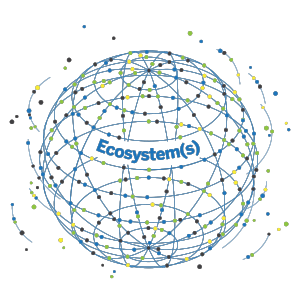Understanding Your Ecosystem Depends on Context
From Wikipedia: “The principle of linguistic relativity holds that the structure of a language affects the ways in which its speakers are able to conceptualize their world, i.e. their world view.”
Said slightly differently, having specific language for things is valuable. Among other things, it allows us to:
- Make distinctions
- Exchange ideas with others who share the same language
- Bring things to “top of mind” consciousness so they can be considered and reflected upon.
As we grappled with how to understand and influence dynamics in the messy, non-linear world of human teams and organizations, we found ourselves struggling to describe the critical “differences that make a difference” – the reasons the same improvement intervention sometimes worked and sometimes didn’t.
Eventually we stumbled upon the concept of a biological ecosystem. From dictionary.com:
“A complex set of natural, interconnected elements on which a habitat’s survival depends directly or indirectly.” commpres.env.state.ma.us/content/glossary.asp
The light bulb came on for us and the concept of an “organizational ecosystem” was born. An ecosystem seemed like an elegant way to describe the context; the “water that the fish swims in but can’t see;” the amorphous “soup” that colors every interaction of a complex system.
Ecosystem(s) Are Patterns in Context or The fish can’t (usually) see the ocean its swimming in.

Within the Complexity Space™, it is our belief that complex systems always exist within a context. That context both shapes, and is shaped by, a number of variables. Those variables influence the patterns of behavior of those interacting within that complex system.
The behavior of fish swimming 100,000 feet below the surface of the ocean – with its intense pressure and total darkness, is very different than a school of fish making its way through light-filled, extremely shallow waters. Fish that thrive in one of those contexts are likely to struggle in the other. Major disruptions within that context can have catastrophic implications for every element of the system. We have chosen to name this organizing principle (concept) “Ecosystem(s).”
As we looked more deeply into this concept, we identified key conditions of the organizational ecosystem that seemed “true and useful” in creating awareness and conversation about any team or organization’s unique context.
 In our view, all Ecosystems share the following properties:
In our view, all Ecosystems share the following properties:
- Always present
- Operate at multiple layers simultaneously
- Not immediately visible
- Not predictably influenced
- Inputs/outputs not proportional
- Exists in the context of a particular place and point in time
- Open to external systems
Each of these properties allows us to focus on the nuances and distinctions in an Ecosystem’s patterns. In upcoming blog posts, we will offer insights into how building new understanding of any one of these principles will immediately shift how you can begin to influence pattern-based change while accomplishing current goals.


